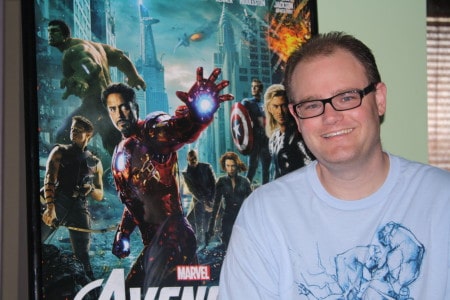
Guest blogger Cory Milles has been teaching writing for nearly a decade. In his spare time, he writes Young Adult novels that seek to capture the power of story to transform his readers. He recently finished writing Paradox, his fourth YA novel, using the Blake Snyder Beat Sheet. When he’s not writing, teaching, or listening to his collection of movie scores, he can usually be found reading more on the craft of writing. He writes a blog on writing called Attacking Ideas 101, which has focused on the Hero’s Journey lately. His chapter on “LOST and the Power of Story” is featured in the book LOST Thought: Leading Thinkers Discuss LOST.
Marvel Studios took a risk when they unveiled their plan to release several superhero films that would eventually culminate in one movie, combining all of their stories. Fans were skeptical: how could the movie do the individual heroes justice while not falling victim to the “too many is too much” affliction that often befalls comic book adaptations that seek to incorporate many characters? Would the plot be understandable to those who had not seen all of the films leading up to this one? Luckily, Marvel and Disney scored big with director Joss Whedon, and their gamble paid off. And it continues to pay off as The Avengers breaks box office records. The secret is not just in the explosive action sequences, the cool costumes and abilities, or even in the witty dialogue. It’s in the story. And of course, the story for The Avengers follows the Blake Snyder Beat Sheet. By the end of the film, Earth’s Mightiest Heroes will go through the Transformation Machine of Thesis, Antithesis, and Synthesis.
Written by: Joss Whedon and Zak Penn
Directed by: Joss Whedon Based on the original comic book characters created by Stan Lee and Jack Kirby
1. Opening Image The film opens on an image of the Tesseract. This source of energy is the key to the entire film, the glowing blue cube that will cause a war between Earth and the Chitauri. It will also cause some of Earth’s mightiest heroes to come together by the final image. During the Opening Image, we see an odd stairway in space leading up to an individual known as only as The Other. We listen as The Other, a villain, provides some insight into who and what the threat is for our world. And it doesn’t take long for this threat to arrive.
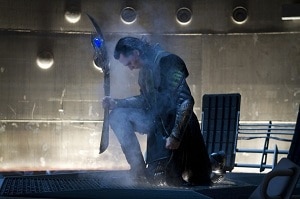
2. Theme Stated After the arrival of Loki and the destruction of the secret NASA base examining the properties of the Tesseract, S.H.I.E.L.D. agent Nick Fury radios Agent Phil Coulson, telling him that we are now at war. This is what the film will revolve around: the idea of conflict and the threat from outside our world as well as from within. To find peace, our protagonists will not only have to defeat the alien threat but also that which threatens to separate them and prevent them from forming a team.
3. Set-Up It should be noted that much of the Set-up for this film has occurred during the previous Marvel movies for the individual superheroes. In Iron Man and Iron Man 2, The Incredible Hulk, Thor, and Captain America: The First Avenger, we learn about their journeys and abilities, and a fair amount of groundwork has been laid. During the Set-up for this film, the basic information we need to know is established. We get our first true glimpse at the cause of the conflict: the Tesseract. It has begun “behaving” on its own, turning itself on when it should not. As Nick Fury descends into the lower levels of the secret complex, we meet several of the main characters. A scientist, Dr. Erik Selvig, has been studying the Tesseract and is not sure why it is acting that way. Agent Clint “Hawkeye” Barton, an expert with arrows, notes that the Tesseract is being studied because it is an energy source that can open a doorway into space… and that doors open from both sides. This is made evident when we see a beam of light shoot from the Tesseract, opening a portal and illuminating the figure of Loki, the banished Norse god. Loki quickly makes his intentions known to steal the Tesseract. Using his scepter, he takes control of the minds of several S.H.I.E.L.D. personnel, including Hawkeye and Dr. Selvig. During his escape, the unstable energy from the Tesseract portal collapses on itself, causing the ground beneath the base to collapse. Despite his efforts, Nick Fury is unable to stop Loki and retrieve the Tesseract.
4. Catalyst After speaking to the World Security Council, Nick Fury decides to take it upon himself to re-activate the Avengers Initiative. While Loki’s theft of the Tesseract is clearly a catalyst that propels the story forward, the bigger story at hand is the formation of the Avengers as a superhero team to stop Loki. Fury’s decision will affect the lives of all of our heroes, as well as our planet itself.
5. Debate During the Debate, we are left to wonder if the heroes Nick Fury has sought out will come together to help stop Loki. We are introduced to Agent Natasha Romanoff, also known as the Black Widow. Agent Romanoff seeks out the elusive Dr. Bruce Banner, an expert in Gamma radiation (and also a victim of it). While he wants to be left alone, he agrees to help in the effort. Agent Coulson seeks out Tony Stark, but Stark does not want to be a part of the situation. He has just made Stark Towers a beacon of self-sustaining green energy using the Arc Reactor as a power source. However, at the prompting of Pepper Potts, Stark agrees to read over the information Coulson provides. After speaking with the World Security Council about locating Loki’s brother Thor, Nick Fury visits Steve Rogers, who is still adjusting to the modern world after being unfrozen and revived. His flashbacks show his anger and confusion, and when Nick Fury tells him the Tesseract has been stolen, Rogers knows all too well that he must step in and aid Fury in this effort. He’s seen the power of the Tesseract in action before. Meanwhile, S.H.I.E.L.D. has no idea where Loki is or how much time they have left before whatever he has planned will be unleashed.
6. Break into Two Nick Fury’s plan to assemble the heroes begins to take shape. He boards the S.H.I.E.L.D. helicarrier with Dr. Banner, Romanoff, and Rogers. The Avengers are beginning to form. The heroes are now stepping into the upside-down world where they will have to work together.
7. B Story While there are many smaller stories within each character arc, the B Story in this movie is the story of friendship between the heroes and their struggle to work together, to trust each other, and to become a team that will fight as one. The B Story will completely meet the A Story (stopping Loki and saving the world) by the Break Into Three.
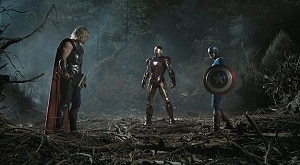
8. Fun & Games Now that the search is on for Loki, the story reveals some of the team dynamics as well as some of the inner-workings of S.H.I.E.L.D. They locate Loki in Germany as he and his team steal some iridium, an element that will stabilize the Tesseract’s energy and will keep the portal open. Unable to resist the ability to subjugate the crowd, Loki transforms and wears his helmet and armor. Demanding that they kneel, he is surprised when one lone elderly German man refuses. As Loki is about to kill the man, Captain America arrives and stops him. Romanoff and Iron Man also arrive, capturing Loki. On the flight back to the S.H.I.E.L.D. helicarrier, a lightning storm reveals that Thor has arrived. He demands that Loki be remanded to him as a prisoner of Asgard, and disappears with Loki to the forest below. Iron Man goes after him, and the two begin to fight over Loki. Captain America steps in to stop the fight, and they take Loki prisoner together. On board the helicarrier again, the team tries to determine where the Tesseract is and what Loki’s plan may be. Team dynamics are tested as Stark shows his admiration for Dr. Banner while jokingly trying to set him off to see the Hulk manifest. Stark also hacks into the computer system and finds some questionable plans that S.H.I.E.L.D. has: to use the powers of the Tesseract in making weapons.
9. Midpoint During the Midpoint, we see the crossing of the A and B Stories as the pace quickens. Romanoff tricks Loki into revealing his plan, which is to “activate” the Hulk to bring down the helicarrier and help him escape, thus letting him open the portal to let the Chitauri in for the invasion. The “time clock” for the attack is imminent. Also, the team suffers a false defeat as they threaten to be torn apart. Confronting Nick Fury about the secret weapons, the team gets into an argument, hurling accusations and insults at each other. As Dr. Banner says, “We’re not a team… we’re a time bomb.” And that time bomb is just about to go off.
10. Bad Guys Close In Clint “Hawkeye” Barton returns and destroys one of the helicarrier’s engines. He and his team also hack into the computer, releasing Loki from the cell that was meant to contain the Hulk if needed. During the attack, Dr. Banner transforms into the Hulk and tears up the helicarrier. Thor fights with him, and Iron Man and Captain America try to get the engine working again while holding back enemy forces. Romanoff fights Barton, and Fury attempts to prevent a total disaster in the control room. Eventually, Hulk leaps off the carrier onto a damaged plane, and Thor is tricked into being sealed inside the cell that once held Loki. Loki releases the cell, dropping it 30,000 feet to the ground below. Iron Man is able to get the engine back online, but not without cost.
11. All Is Lost Agent Coulson confronts Loki and is stabbed by his spear. Loki escapes, the team is split up, and the helicarrier is heavily damaged. All is lost for the team as they realize the impossibility of learning of Loki’s plan and how to stop him. Nick Fury finds Agent Coulson, who soon dies while saying that he was okay with it because the heroes needed something to prompt them into action. The “whiff of death” is in the air.
12. Dark Night of the Soul The team is now split up. As Tony Stark and Steve Rogers sit together, defeated, Nick Fury tosses blood-stained, vintage Captain America trading cards onto the table. They belonged to Agent Coulson, the one who never gave up believing in heroes. After Fury leaves, Rogers and Stark argue what to do next. The theme breaks through loud and clear as Stark shuns the idea that they are soldiers. Suddenly, they realize what Loki will do next, and where his portal will get its energy source from: Stark Tower.
13. Break into Three The heroes make a decision. Iron Man and Captain America, along with Black Widow and Hawkeye, head to Manhattan to try and stop Loki. Thor has escaped plummeting to his death and seeks to join them, while Dr. Banner recovers from his fall thanks to his transformation as the Hulk. Stark confronts Loki in Stark Tower, telling him about the Avengers. The theme of the struggle being a war comes full circle in what Stark tells Loki: “Maybe your army comes and maybe it’s too much for us, but it’s all on you. Because if we can’t protect the Earth, you can be damned well sure we’ll avenge it!” The A Story and the B Story completely meet: the heroes will save the world, and they will become a team to do so.
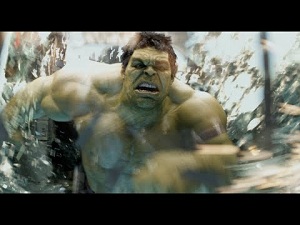
14. Finale Gathering the Team: The heroes converge on the streets of Manhattan and plan to hold off the army as long as possible while trying to find a way to close the portal. Iron Man will take to the skies, while the others will protect the civilians on the street. Thor will deal with Loki and try to speak some sense into him while they wait for Dr. Banner to arrive. The invasion has begun. Storming the Castle: The Avengers fight the Chitauri on land and in the air. The battle rages and they are outnumbered. Dr. Banner arrives, using his anger to turn into the Hulk and provide some much-needed muscle. Combined and working as a team, the Avengers are able to hold their own, but they need to find a way to close the portal. Black Widow is able to make it to the top of Stark Tower on a Chitauri glider, and finds out Dr. Selvig knows of a way to close the portal and end this battle… High-Tower Surprise: …but the World Security Council wants to end it on their own terms, by striking the island of Manhattan with a nuclear bomb. Nick Fury tries to convince them to let the Avengers fight the Chitauri off, but despite his efforts, a plane with a nuclear bomb heads toward the city. “Dig, Deep Down”: Iron Man, aware of the situation, takes it upon himself to stop this from happening. Grabbing hold of the bomb, he takes it toward the portal to send it to the Chitauri ship. He knows it’s a one-way ticket, but he is willing to sacrifice everything to protect mankind in this war. The team member who was the most selfish one is willing to give up his own life to save others. Executing the New Plan: Iron Man sends the bomb into the portal, and as it detonates, he falls back to Earth, making it through the portal just in time before Black Widow closes it completely. The Avengers re-capture Loki and hand over the Tesseract to Thor. Earth is saved.
15. Final Image Nick Fury tells Agent Hill that the Avengers will go their separate ways, but they will come back if they are needed. Proof of this is seen in the final image: as the camera zooms out from Tony Stark and Pepper Potts in Stark Tower, the only letter in “STARK” that is still illuminated after the battle is the only one that will matter: the “A.”
Cory Milles
14 Comments
Leave a Reply Cancel reply
You must be logged in to post a comment.


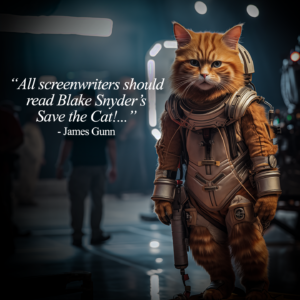
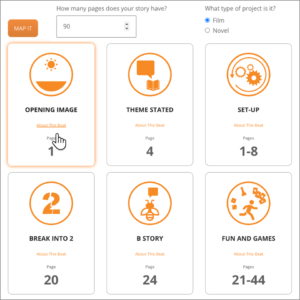





Great breakdown! :-)
I’ve been thinking about the Beat Sheet for the Avengers for a few days, and the theme that came to mind was the dynamics of Order and Chaos. Or, specifically, “A bit of Chaos is needed to restore Order.”
The most evident representation of Chaos is Loki (as the god of discord, no less), and the Avengers as a team represented Order. In the beginning, the Avengers wasn’t exactly Order, since the individual motivations weren’t in synch.
Loki’s presence in the Helicarrier did add to the Chaos when the heroes started questioning each other, and Loki also intended for the Hulk (another representation of Chaos) to wreak havoc and further prevent the team from solidifying.
An interesting twist happens when Nick Fury shows Captain America and Iron Man the blood-drenched trading cards of Agent Coulson. Coulson had the trading cards in his pocket, Fury says, even though the cards were actually in Coulson’s locker. Fury “tricked” the heroes to give them the motivation to press on. In a sense, Chaos was used to inspire Order.
Later, when asked about transforming into the Hulk to help fight the Chitauri, Dr. Banner says, “I’m always angry.” This is another suggestion of how Chaos is used to keep things in Order.
In the final battle, Captain America instructs the team members on what to do. His instructions to the Hulk, however, was simply “Smash.” It’s another acknowledgement that a bit of Chaos is needed to bring about Order. This coincides with the Security Council’s decision to unleash a nuclear warhead (Chaos) to end the battle (and restore Order.)
All this culminates in that fan-favorite moment when the Hulk treats Loki like a rag doll–Chaos defeats Chaos.
Come the denouement, the heroes go on their separate ways. They are individuals, but they are a team. Chaos and Order, in harmony.
Just my two cents. :-)
Thanks for the compliment, and for the excellent suggestion of theme. I have to agree with you; on a deeper level, it completely makes sense! Especially with Hulk smashing Loki… it seems to suggest that Chaos will inevitable collapse on itself. Thanks for your contribution. You gave me something to think about, and it has made the movie richer for me, too!
@Carlo, I was on the same wave length as Cory, but I found your perspective spot on… once you spelled it out.
Cheers,
Paul
Carlo, I love reading people articulate their conclusion and and the thoughtful reasons that led to it. Great take on theme.
Cory, I wish you were teaching my kids. Both are story nerds (said with affection, plagiarized from a Josh Brolin interview for “No Country for Old Men”).
Scott
amazing! Way to go! Loved the movie…love your succinct recounting of the beats!
Oh wow! Thanks, all. I’m a “Save the Cat” fan in recluse, really. Downloaded version 3 of the software, and breaking down stories whenever I can. I’m primarily a graphic designer, but I also make graphic novels, and Save the Cat has been one of the resources that’s been helping me a lot. One day, I hope to master STC. All the best to everyone! :-)
I actually saw a different theme in the film. Now these things are always open to interpretation, but as the Other speaks in the beginning he says, “And the humans? What can they do, but burn.” I felt that that was theme of the movie. When faced with a threat, what will you do? Even when Natasha interrogates Dr. Banner, he smashes the table and she pulls out her gun. After seeing this Banner says, “I just wanted to see what you would do.”
Also, I saw the midpoint as a false victory. The team stoppped Loki from killing the old man and worked together. That scene was also a keystone scene because it carried the theme as the humans kneeled before Loki, one man stood up. Of course, this is all just one humble opinion. Movie still rocked.
That’s right, the genre of Avengers was ‘Dude With a Problem’ or in this case, ‘Dudes with Big Problems’ -)
I love the discussion on the theme. I, too, sensed a significance when Dr. Banner slammed the table and Natasha’s reaction was one of fear and uncertainty. I also agree that the scene with the old man standing up was definitely a crucial point… perhaps my favorite beat of the film. The reason I thought the team breaking up was the midpoint was because they were all together, and that was where I thought the A story and the B story crossed very evidently, although I can sense it in that scene, too. Thanks for the opinion!
Cory, which Save the Cat! genre would you classify The Avengers as? With the collection of the group of people my mind first thought Institutionalized with the choice being to work together (or not to) and the sacrifice being individuality and succeeding alone, but I don’t think it fits very well. My next thought was was Buddy Love (or Buddies Love) because they’re all clashing and struggling to work together like a large scale ‘Professional Love’ movie; a group-sized Lethal Weapon or 48 hours. But I like Isaac’s comment that it’s Dudes with a Problem. What do you think?
Wow! Good points… I can see it maybe as a hybrid of all of them. I definitely agree that from the start, it seems like a “Dudes with a Problem” story type. Loki causes the problem, and the heroes all have to work together to save the world. I can see elements those other genres as well… the story is sort of about their relationship together, and their lives are better (by the end) for having known each other. Tony Stark finds out he does need others more than he realized, Steve Rogers finds his “place” in the modern world, and Dr. Banner finds acceptance of who and what he is as The Hulk. There’s even the scene where Stark suggests that maybe his becoming the Hulk is his salvation, just as Stark’s mini Arc-Reactor in his chest is his salvation. If you look at each hero, their abilities and what makes them special is also their “cross to bear,” which is what makes them so interesting. So I think this one has elements of several genres in it, although I think the big, A-Story genre would be “Dudes with a Problem.”
In an earlier post, we discussed the midpoint. I thought about it more, and the reason I did not include Loki’s capture as the midpoint is because in the Fun & Games section, this is where we get the “promise of the premise” as Blake said. We want to see a movie where superheroes and villains fight it out and interact with each other, and we definitely see that. Up until that point, there is not a lot of the “promise of the premise” that is very obvious. In my opinion, the theme of them coming together as a group and trusting each other doesn’t really begin to “gel” until after that… but of course, it falls apart quickly, which is why I felt it was a “false defeat.” But of course, that’s just my opinion, and I love the discussion that it brings up. I think it’s a blast discussing stories and taking them apart.
Blake would have loved this discussion. He considered the beats and his terms a “language” to analyze film — and this kind of “debate” would be music to his ears.
I would have loved to discuss story structure with Blake. I feel like he and I think alike, and it all goes back to having that common language. In fact, I remember reading his breakdown of Spider-Man 2 and thinking, “Wow! That’s exactly what I think!” It inspired me to begin thinking of my favorite film beats, and after a long time, I finally got around to writing about some of them in my latest blog post. I’m very thankful and enouraged to have the Cat Community to discuss ideas and movies with. Whenever I think I’m the only one who looks so deeply into films, I just need to turn to this site, and I see that I’m not alone!
Actually, having seen the film for a third time and doing a lot of rethinking, I must admit that my original Beat Sheet analysis is a bit off from where it should be. Seeing the film again, I think I would place the Midpoint a bit earlier after Loki is captured. This marks a “false victory” for the heroes, which will meet its mirror opposite of the “All is Lost” moment later, the “false defeat.” While it’s a small change from my original thinking, I believe it is important to note. That’s why I love these discussions… they keep us thinking!